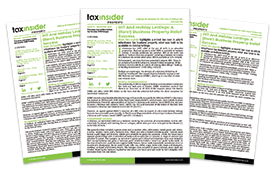Before you go, sign up to our free tax saving email course. Get 7 top property tax saving strategies in your email inbox that will help you save thousands in tax. Unsubscribe any time.
 Mark McLaughlin highlights an important distinction between the incorporation of an ‘ordinary’ partnership of individuals and a limited liability partnership into a company. Mark McLaughlin highlights an important distinction between the incorporation of an ‘ordinary’ partnership of individuals and a limited liability partnership into a company.A limited liability partnership (LLP) is treated like an ‘ordinary’ partnership in many respects. However, an important distinction arises where a business incorporates into a company. Separate legal entities Like a company, an LLP is a separate legal entity. When (for example) a business carried on by an ordinary partnership of individuals is incorporated into a company, the transaction is between the individuals (as partners) and the company. By contrast, had the partnership been an LLP, the transfer of the LLP’s business would be a transaction between the LLP (as the legal entity ‘owning’ the business) and the company. It’s not yours! This means that if (say) the company pays for the business in cash, the disposal proceeds ‘belong’ to the LLP in legal terms, rather than its members. Thus, the individuals would not immediately receive the proceeds. Consideration would need to be given in the above example to the LLP distributing the cash (and any other assets) to its members immediately after the incorporation (subject to the LLP being able to satisfy its creditors). The LLP agreement (assuming there is one) will generally determine the basis of distribution of the LLP’s net assets to its members. An LLP might not necessarily sell its business for cash; it might sell for shares in the company instead, or even gift the business. When an ordinary partnership of individuals has incorporated its business into a company, the partnership will normally cease to exist. However, when an LLP’s business is incorporated into a company, the LLP will continue as a legal entity (unless it is dissolved), despite no longer carrying on the business. Don’t forget the tax… There are various tax issues to consider when a buy-to-let property LLP incorporates its business into a company. These include land taxes (i.e. stamp duty land tax in England and Northern Ireland, land and buildings transaction tax in Scotland, and land transaction tax in Wales), income tax for the individual LLP members and corporation tax for the company. For capital gains tax (CGT) purposes, the disposal of the buy-to-let property business to the company will normally be treated as a disposal at market value. Consideration of the tax implications is beyond the scope of this article. However, it should be noted that CGT ‘incorporation relief’ (TCGA 1992, s 162) is available to individual LLP members (as for individual members of an ordinary partnership) on the incorporation of the LLPs rental property business if the relief conditions are satisfied. The LLP is ‘looked through’ for these purposes (TCGA 1992, s 59A(1); see HMRC’s Capital Gains manual at CG65700). Don’t delay? However, the LLP’s tax transparency is lost for CGT (and income tax) purposes when it ceases to carry on a business (unless the cessation is only temporary); but if the LLP is wound up following the permanent cessation of business the tax transparency is retained if the winding up is unconnected with tax avoidance and is not unreasonably prolonged, provided that (among other things) a liquidator is not appointed (see TCGA 1992, s 59A(4)); ITTOIA 2005, s 863(3)). This is a sample article from the monthly Property Tax Insider magazine. Go here to get your first free issue of Property Tax Insider. |


 Tax Articles
Tax Articles